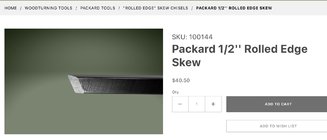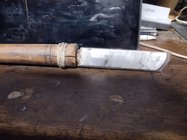Well, I do have one of the Trend diamond plates, and the quality of it is not nearly as good as the lapping plates from DMT. The plates from DMT that have all the holes in them are on par with the Trend plate. The solid ones, the lapping plates and not the 'sharpening' stones, from DMT are much better, and pretty much dead flat. They do have 4000 and 8000 grit plates, and diamond stropping pastes up to 15000. I do have more 'experimenting' ahead to see if the stone leaves a better surface than the stropping pastes. I did try the 15000 stropping paste on some big leaf maple yesterday, and no real difference that I can tell, but I am not competent with the skew..... I can polish a bench chisel sideways or up and down, and the results are the same. My Trend plate is slightly concave on one side, the 320, I think, and convex on the other side. Still haven't gotten to the Shapton 16000 grit stone yet. DMT said to use water. A couple of other sources say to use automotive glass cleaner which doesn't have ammonia in it. Supposedly the ammonia can bother the electroplate bond of the diamonds.
robo hippy


